Marking post
As a rule, if the manufacturer does not give unique device models, then a pattern can be found in their labeling.

Today I will tell you a few words about the name formation of some devices from ASUS, in particular - netbooks and laptops.
Let's first talk about netbooks. Take, for example, the model ASUS EeePC 1005HAG .
')
“ Eee ” in “hedgehogs” means “ Easy to Learn, Easy to work, Easy to play ”. Everyone knows that one of the main advantages of netbooks is their compact size - I do not remember such a device that would not fit even in the smallest backpack. And the size dictates the size of the display - it was she who formed the basis of the name of each netbook. The first two digits indicate the diagonal of the screen - here it is 10 inches (more precisely, 10.1). So in models 7xx, 9xx, 11xx and 12 xx diagonal screens are 7, 9, 11 and 12 inches, respectively.
The next two numbers, in fact, do not mean anything - this is just the serial number of the model in the series. After three or four numbers there are letter symbols. In this case, the letter H means that a hard disk (HDD) is used inside, and not an SSD. A - "motor" is the processor Intel Atom. G - availability of WiMAX module. Those. by name alone, it can be understood that this is a very modern model that will be of particular interest to residents of Moscow, St. Petersburg, Ufa and some other million-plus cities. The rest of the alphabet looks like this:
A - The presence on board the processor Intel Atom;
D - The presence on board the processor Intel Celeron-M (Dothan);
DN - availability of a disk drive (only in model 1004DN );
E - High-capacity battery (for example, in 1000HE as much as 8700 mAh);
H - Hard disk presence instead of SSD-drive;
G - Availability of built-in WiMAX module;
KR - Designed by Karim Rashid (model 1008P-KR only );

P - Availability on board the new Intel Atom processor (Pine Trail);
S - SSD-drive instead of a hard disk;
T - touch screen (Touch). MT - multitouch.
X - Pre-installed Windows XP.
The letter X is almost never used and was before, for example, in the EeePC 701SDX model. However, some other characters are also very rare.
Some exceptions are the T91 and S101 transformer netbook. The letter T means that the rotary touch screen is used. In the model T91MT screen is multi-touch. Accordingly, in T101MT just a little bigger screen.
S101 - just a stylish netbook.
There are also posts 2G , 4G , 8G (in the "old" models - the volume of the built-in SSD-drive in GB), Surf (no webcam) and GO (the presence of a built-in UMTS module).
Eh, you also dream of a matte EeePC 1101PEGST ? :)

With laptops, everything is somewhat more complicated. The first thing to remember about laptops from ASUS - they are all divided into 3 large segments. These are SOHO (Small Office / Home Office), business notebooks and multimedia notebooks . And "Business" is divided into two categories - mobile and ultra-mobile. Those. there is no such thing that any series completely belongs to a certain category - practically in every line of devices there are representatives of one or another class.
SOHO . The main criteria for this segment of notebooks: the most budget price, screen size 15 "-17", built-in graphics system (non-discrete), mostly stationary use, is intended for typical office tasks.
Ultra-mobile laptops . Diagonal up to 12 "inclusive, compact dimensions and low weight - up to 2 kg; mostly mobile use, for office business tasks.
Mobile laptops . Diagonal 13 "-14" inclusive, a combination of compactness, functionality and performance; versatility of use in the office and beyond.
Multimedia laptops . Screen diagonal from 15 '', discrete graphics card for intensive work with graphics, powerful processor and large amounts of memory. Most often designed for stationary use, but there are mobile models. The most expensive category; it also includes all gaming laptops.
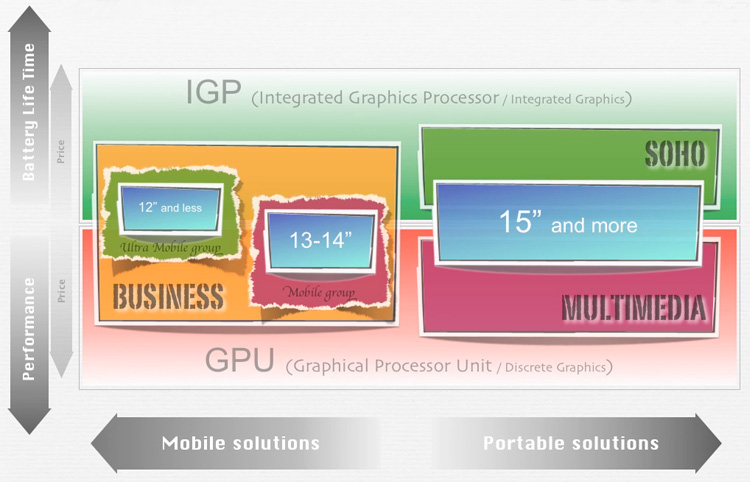
The name of each model carries a lot of information, which is “easy to read” - it’s enough just 1 time to figure out what's what.
Usually in the name of the model from three to five characters - consider a few cases, ASUS UL30Vt , ASUS G72Gx and ASUS G51J-3D .
The first letter is mandatory and denotes a series. Those. in front of us is the U-series. The second letter (L) is optional and is a series modifier. There are two of them - L (Thin and light) and X (eXtraordinary). Accordingly, it is known that we have a thin and light laptop.
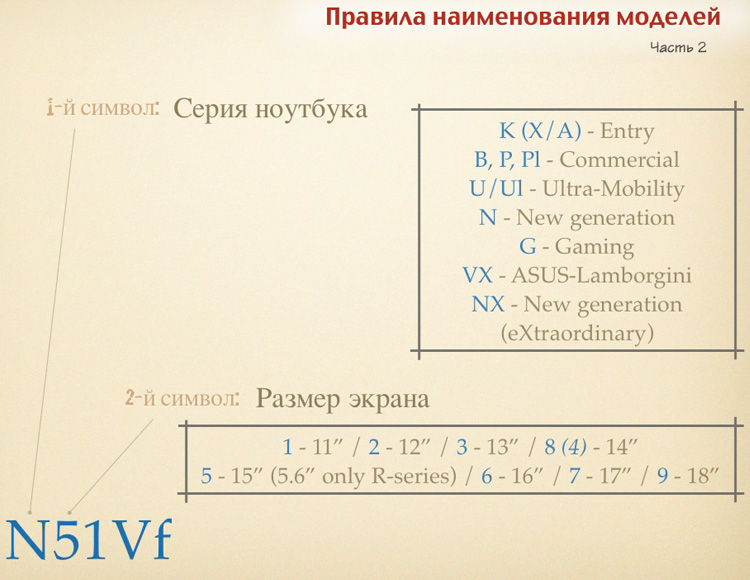
There are several series:
K (A / F / X) - budgetary, initial level;
R (UMPC) - the most mobile devices, but not netbooks;
B, P, PL - will appear very soon and are intended for office use;
M (Multimedia) - multimedia laptops;
U / UL (UX removed) - thin, stylish and productive laptops;
N (New generation) - powerful enough devices for a wide range of tasks;
G (Gaming) - gaming laptops, they are also the RoG (Republic of Gamers) series;
VX (Lamborghini) - a series of image devices;
W (Wide) - the rarest and most expensive, with a huge screen and two video cards.
NX (New generation, eXtraordinary) - the very best of the "available".
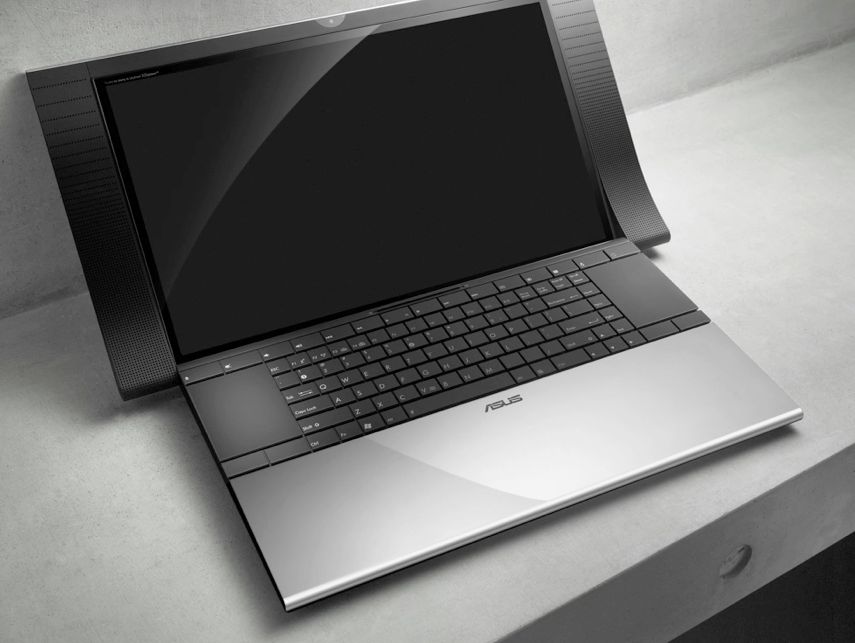
More clearly all the series can be divided into categories, you get this picture (some models are not on it):
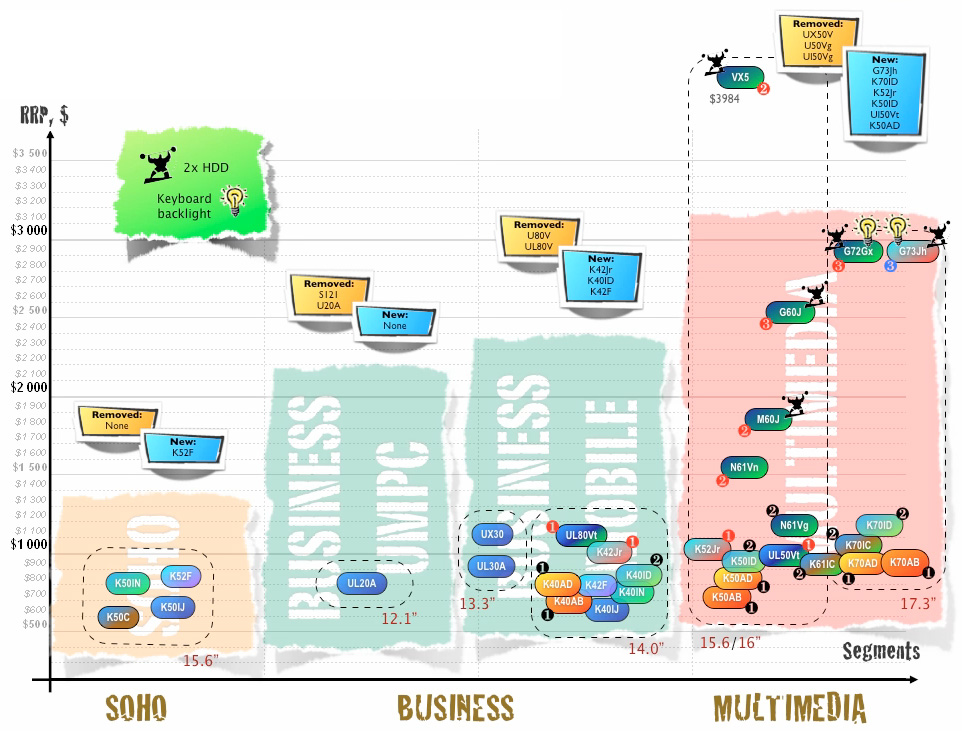
Clickable

Next comes the number - it denotes the diagonal of the device. In this case, it is 13 inches. So laptops UL20 , UL30, UL50 are already lined up. And where, ask, 14-inch screen? In theory, it should be UL40 ... but in reality it is called UL80 - due to the fact that the hieroglyph denoting the number 4 is a homonym of the word "death", oriental craftsmen prefer not to use it. Such is the exception.
Zero in the title (second digit) is mandatory - this is the serial number of the device in the series. Accordingly, of the two laptops, for example, K50 and K52 (about which I recently wrote ), the newer will be the second.
After the numbers are two optional letters, the first of which usually speaks about the platform, and the second is also a modifier. In more detail - in a picture:
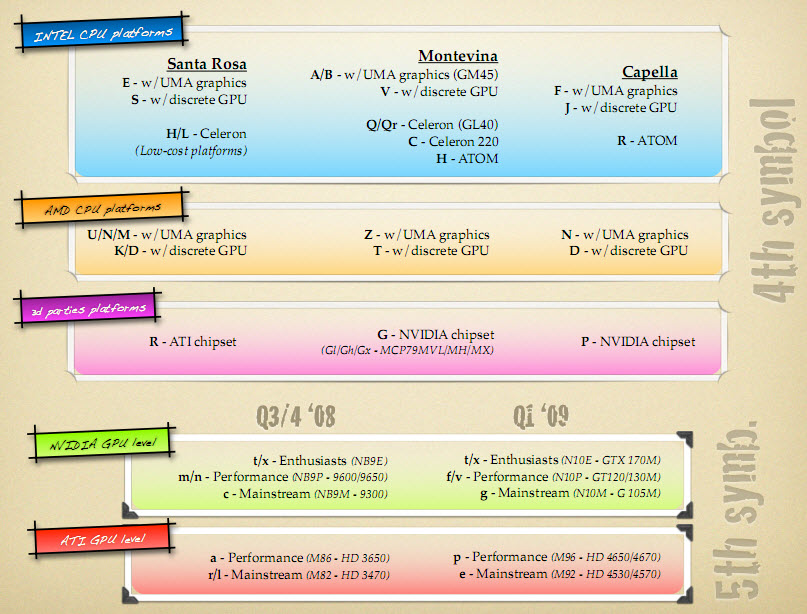
Here, except that the meaning of the letter “ J ” has changed - now it means that inside the notebook new Core processors are used (i3 / i5 / i7). M60J , K52J, G51J - everywhere new “crusts”.
Clearly, the text above can be understood from the following scheme:
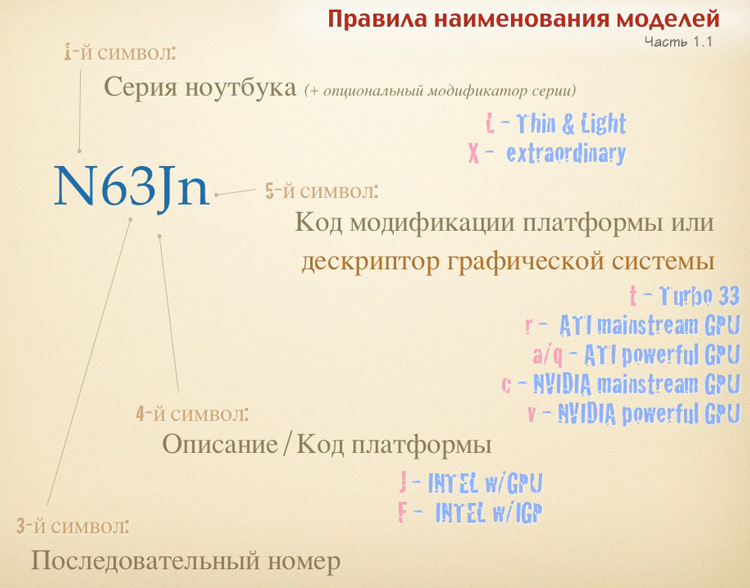
Some exceptions to the rule are the budget K-series, the naming of which models is difficult to remember:
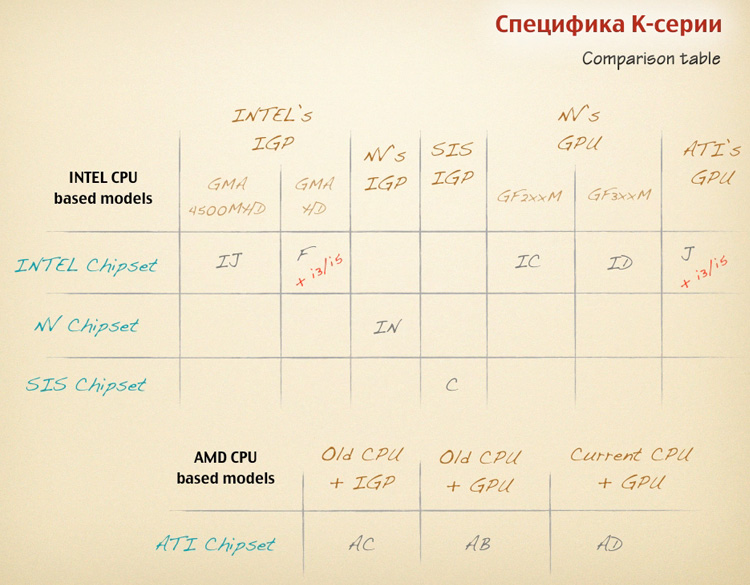
It is immediately clear that these are two gaming laptops, the first one being the second in the series and has a screen diagonal of 17 inches.
However, the G51J-3D is newer - despite the fact that it is the first gaming laptop with a 15-inch screen, it uses a new Core processor, as evidenced by the letter J. Well, another thing is the “3D” subscription, which signals that the device is capable of displaying a 3D image. Accordingly, the “small” screen is there because it would be somewhat more difficult to provide a scan at 120 Hz on a large diagonal (and more expensive).
The following picture will help clarify the G-series:

You can practice: K40IJ, K52, UL20A, UL50Vt, UL80, M60J, N61, G60J, VX5.
It is even strange that not a single laptop has received a separate sonorous name (the VX Lamborghini series does not count). By the way, the VX-series is simply numbered in order - VX1, VX2 ... VX5 .
As you can see, there is nothing complicated and everything is quite logical. You can go to the site and run through the eyes of the configurations that are installed inside those or other models. And already after this, an understanding will finally come to you what is in front of you for the copy, what is inside it, what tasks it is for and how much it costs. All laptops in one place are on the AsusNB website.
There are, of course, much more detailed decryptions (of which almost everything can be found, including the type of drive or OS language installed on the device), but it’s not just the name of the model, but all sorts of bar codes and other labels on the labels. This information is mostly “secret” and is intended primarily for suppliers.
Successes!

Today I will tell you a few words about the name formation of some devices from ASUS, in particular - netbooks and laptops.
Let's first talk about netbooks. Take, for example, the model ASUS EeePC 1005HAG .
')
“ Eee ” in “hedgehogs” means “ Easy to Learn, Easy to work, Easy to play ”. Everyone knows that one of the main advantages of netbooks is their compact size - I do not remember such a device that would not fit even in the smallest backpack. And the size dictates the size of the display - it was she who formed the basis of the name of each netbook. The first two digits indicate the diagonal of the screen - here it is 10 inches (more precisely, 10.1). So in models 7xx, 9xx, 11xx and 12 xx diagonal screens are 7, 9, 11 and 12 inches, respectively.
The next two numbers, in fact, do not mean anything - this is just the serial number of the model in the series. After three or four numbers there are letter symbols. In this case, the letter H means that a hard disk (HDD) is used inside, and not an SSD. A - "motor" is the processor Intel Atom. G - availability of WiMAX module. Those. by name alone, it can be understood that this is a very modern model that will be of particular interest to residents of Moscow, St. Petersburg, Ufa and some other million-plus cities. The rest of the alphabet looks like this:
A - The presence on board the processor Intel Atom;
D - The presence on board the processor Intel Celeron-M (Dothan);
DN - availability of a disk drive (only in model 1004DN );
E - High-capacity battery (for example, in 1000HE as much as 8700 mAh);
H - Hard disk presence instead of SSD-drive;
G - Availability of built-in WiMAX module;
KR - Designed by Karim Rashid (model 1008P-KR only );

P - Availability on board the new Intel Atom processor (Pine Trail);
S - SSD-drive instead of a hard disk;
T - touch screen (Touch). MT - multitouch.
X - Pre-installed Windows XP.
The letter X is almost never used and was before, for example, in the EeePC 701SDX model. However, some other characters are also very rare.
Some exceptions are the T91 and S101 transformer netbook. The letter T means that the rotary touch screen is used. In the model T91MT screen is multi-touch. Accordingly, in T101MT just a little bigger screen.
S101 - just a stylish netbook.
There are also posts 2G , 4G , 8G (in the "old" models - the volume of the built-in SSD-drive in GB), Surf (no webcam) and GO (the presence of a built-in UMTS module).
Eh, you also dream of a matte EeePC 1101PEGST ? :)

With laptops, everything is somewhat more complicated. The first thing to remember about laptops from ASUS - they are all divided into 3 large segments. These are SOHO (Small Office / Home Office), business notebooks and multimedia notebooks . And "Business" is divided into two categories - mobile and ultra-mobile. Those. there is no such thing that any series completely belongs to a certain category - practically in every line of devices there are representatives of one or another class.
SOHO . The main criteria for this segment of notebooks: the most budget price, screen size 15 "-17", built-in graphics system (non-discrete), mostly stationary use, is intended for typical office tasks.
Ultra-mobile laptops . Diagonal up to 12 "inclusive, compact dimensions and low weight - up to 2 kg; mostly mobile use, for office business tasks.
Mobile laptops . Diagonal 13 "-14" inclusive, a combination of compactness, functionality and performance; versatility of use in the office and beyond.
Multimedia laptops . Screen diagonal from 15 '', discrete graphics card for intensive work with graphics, powerful processor and large amounts of memory. Most often designed for stationary use, but there are mobile models. The most expensive category; it also includes all gaming laptops.

The name of each model carries a lot of information, which is “easy to read” - it’s enough just 1 time to figure out what's what.
Usually in the name of the model from three to five characters - consider a few cases, ASUS UL30Vt , ASUS G72Gx and ASUS G51J-3D .
ASUS UL30Vt
The first letter is mandatory and denotes a series. Those. in front of us is the U-series. The second letter (L) is optional and is a series modifier. There are two of them - L (Thin and light) and X (eXtraordinary). Accordingly, it is known that we have a thin and light laptop.

There are several series:
K (A / F / X) - budgetary, initial level;
R (UMPC) - the most mobile devices, but not netbooks;
B, P, PL - will appear very soon and are intended for office use;
M (Multimedia) - multimedia laptops;
U / UL (UX removed) - thin, stylish and productive laptops;
N (New generation) - powerful enough devices for a wide range of tasks;
G (Gaming) - gaming laptops, they are also the RoG (Republic of Gamers) series;
VX (Lamborghini) - a series of image devices;
W (Wide) - the rarest and most expensive, with a huge screen and two video cards.
NX (New generation, eXtraordinary) - the very best of the "available".

More clearly all the series can be divided into categories, you get this picture (some models are not on it):

Clickable

Next comes the number - it denotes the diagonal of the device. In this case, it is 13 inches. So laptops UL20 , UL30, UL50 are already lined up. And where, ask, 14-inch screen? In theory, it should be UL40 ... but in reality it is called UL80 - due to the fact that the hieroglyph denoting the number 4 is a homonym of the word "death", oriental craftsmen prefer not to use it. Such is the exception.
Zero in the title (second digit) is mandatory - this is the serial number of the device in the series. Accordingly, of the two laptops, for example, K50 and K52 (about which I recently wrote ), the newer will be the second.
After the numbers are two optional letters, the first of which usually speaks about the platform, and the second is also a modifier. In more detail - in a picture:

Here, except that the meaning of the letter “ J ” has changed - now it means that inside the notebook new Core processors are used (i3 / i5 / i7). M60J , K52J, G51J - everywhere new “crusts”.
Clearly, the text above can be understood from the following scheme:

Some exceptions to the rule are the budget K-series, the naming of which models is difficult to remember:

ASUS G72Gx and ASUS G51J-3D
It is immediately clear that these are two gaming laptops, the first one being the second in the series and has a screen diagonal of 17 inches.
However, the G51J-3D is newer - despite the fact that it is the first gaming laptop with a 15-inch screen, it uses a new Core processor, as evidenced by the letter J. Well, another thing is the “3D” subscription, which signals that the device is capable of displaying a 3D image. Accordingly, the “small” screen is there because it would be somewhat more difficult to provide a scan at 120 Hz on a large diagonal (and more expensive).
The following picture will help clarify the G-series:

You can practice: K40IJ, K52, UL20A, UL50Vt, UL80, M60J, N61, G60J, VX5.
It is even strange that not a single laptop has received a separate sonorous name (the VX Lamborghini series does not count). By the way, the VX-series is simply numbered in order - VX1, VX2 ... VX5 .
As you can see, there is nothing complicated and everything is quite logical. You can go to the site and run through the eyes of the configurations that are installed inside those or other models. And already after this, an understanding will finally come to you what is in front of you for the copy, what is inside it, what tasks it is for and how much it costs. All laptops in one place are on the AsusNB website.
There are, of course, much more detailed decryptions (of which almost everything can be found, including the type of drive or OS language installed on the device), but it’s not just the name of the model, but all sorts of bar codes and other labels on the labels. This information is mostly “secret” and is intended primarily for suppliers.
Successes!
Source: https://habr.com/ru/post/88684/
All Articles